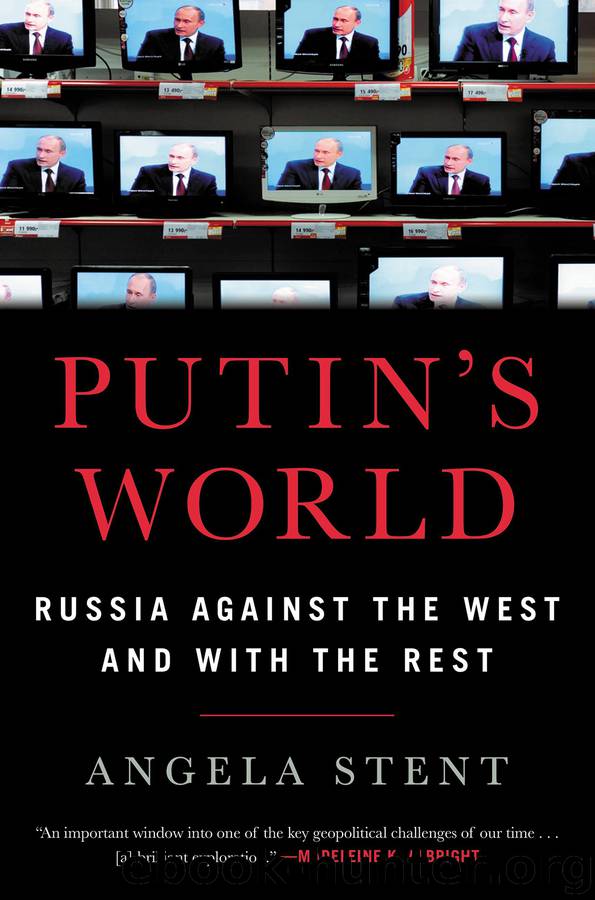Putin's World : Russia Against the West and With the Rest (9781538732595) by Stent Angela

Author:Stent, Angela
Language: eng
Format: epub
Publisher: Hachette Book Group USA
Published: 2019-02-04T16:00:00+00:00
NORMALIZATION CONTINUES—THE YELTSIN YEARS, 1992–1999
Boris Yeltsin’s main foreign policy focus was on the West. Nevertheless, the new Russian leadership soon accepted that it had to continue on the path toward normalization with Beijing.28 The Russian leadership realized that it had to accept the one-China policy even as it sought to improve economic links with Taiwan. During Yeltsin’s tenure, the border issues that continued to plague the relationship were gradually settled, and economic ties—including military sales—increased. Russia was at first wary of fully endorsing China’s calls for a multipolar world. But when Yevgeny Primakov became foreign minister in 1996, Russia’s foreign policy focused more on balancing between West and East, and China began to occupy a more prominent place in the Kremlin’s priorities. But the new pluralism and decentralization of the Yeltsin era also posed new challenges for the Kremlin’s China policy: officials in the Russian Far East were wary of what were called Chinese “shuttle traders,” who came across the border and began to dominate the local market. Once the border opened up, the number of Chinese laborers in the Far East ranged from 300,000 to 1 million, depending on whose estimates one believed.
Yeltsin made his first presidential visit to Beijing in December 1992, although he had to cut it short because of a political crisis at home when acting prime minister and chief economic reformer Yegor Gaidar was ousted. Joking that the number of bilateral agreements they did sign during their truncated meeting might qualify for the Guinness Book of World Records, Yeltsin announced, “We agree that the long period of artificial cold war is now over, and we are now entering a new stage of de-ideologized relations.”29 Russia and China pledged not to enter into alliances or treaties that would hurt the other’s “state sovereignty and security interests.” Indeed, this first visit set the foundation for the relationship going forward.
This new bilateral relationship focused on economic ties, regulating border issues, and noninterference in each other’s domestic affairs. China and Russia both faced separatist challenges—Tibet and Xinjiang for China and Chechnya for Russia. Beijing supported Yeltsin’s Chechen campaign, saying the Russian leader had to wage war in order to preserve the country’s unity.
The Chinese remained wary of the unpredictability of the early Yeltsin years and of its pro-Western policies. But the newly porous borders required attention. As PRC president Jiang Zemin noted, “When a door is opened, people can come into a room, but flies can get in too. We must go about this in such a way that there will be fewer flies.” The delimitation of the Russo-Chinese border was achieved through a series of arrangements in the 1990s. But the collapse of the USSR had left China with a series of new Central Asian neighbors too. China also faced the challenge of dealing with extremism and Islamic movements emanating from the Uighur population in Xinjiang, which shares a border with Russia and several Central Asian countries. In 1996, Russia, China, Kazakhstan, Kyrgyzstan, and Tajikistan—the “Shanghai Five”—signed a border pact and pledged not to attack each other.
Download
This site does not store any files on its server. We only index and link to content provided by other sites. Please contact the content providers to delete copyright contents if any and email us, we'll remove relevant links or contents immediately.
| Arms Control | Diplomacy |
| Security | Trades & Tariffs |
| Treaties | African |
| Asian | Australian & Oceanian |
| Canadian | Caribbean & Latin American |
| European | Middle Eastern |
| Russian & Former Soviet Union |
The Secret History by Donna Tartt(18165)
The Social Justice Warrior Handbook by Lisa De Pasquale(11954)
Thirteen Reasons Why by Jay Asher(8455)
This Is How You Lose Her by Junot Diaz(6440)
Weapons of Math Destruction by Cathy O'Neil(5832)
Zero to One by Peter Thiel(5494)
Beartown by Fredrik Backman(5360)
The Myth of the Strong Leader by Archie Brown(5239)
The Fire Next Time by James Baldwin(5017)
How Democracies Die by Steven Levitsky & Daniel Ziblatt(4959)
Promise Me, Dad by Joe Biden(4908)
Stone's Rules by Roger Stone(4860)
100 Deadly Skills by Clint Emerson(4691)
A Higher Loyalty: Truth, Lies, and Leadership by James Comey(4552)
Rise and Kill First by Ronen Bergman(4545)
Secrecy World by Jake Bernstein(4389)
The David Icke Guide to the Global Conspiracy (and how to end it) by David Icke(4381)
The Farm by Tom Rob Smith(4324)
The Doomsday Machine by Daniel Ellsberg(4246)
